Unveiling the Drivers of Unplanned Urbanization: A High-Resolution Night Light Development Index Approach for Assessing Regional Inequality and Urban Growth in Dhaka
Abstract
1. Introduction
2. Materials and Methods
2.1. Study Area
2.2. Data Sources
2.2.1. Daytime Remote Sensing Data
2.2.2. Nighttime Remote Sensing Data
2.2.3. World Population Data
2.3. Data Preprocessing
Changes in Land Cover for Dhaka City
2.4. Accuracy Assessment
2.5. Identification of Electricity Coverage Through NTL Radiance
2.6. Calculation of the NLDI
3. Results
3.1. Land Use/Land Cover Change in Dhaka City over the Past Decade
3.2. Changes in Electrification over the Past Decade
3.3. NLDI Values and Changes in the NLDI Values over the Past Decade
4. Discussion
5. The Limitations of This Study
6. Conclusions
Supplementary Materials
Author Contributions
Funding
Data Availability Statement
Conflicts of Interest
References
- World Bank Open Data. 2023. Available online: https://data.worldbank.org/indicator/EG.ELC.ACCS.ZS?locations=BD (accessed on 1 December 2024).
- Ma, T.; Zhou, C.; Pei, T.; Haynie, S.; Fan, J. Quantitative estimation of urbanization dynamics using time series of DMSP/OLS nighttime light data: A comparative case study from China’s cities. Remote Sens. Environ. 2012, 124, 99–107. [Google Scholar] [CrossRef]
- Rahaman, M.A.; Kalam, A.; Al-Mamun, M. Unplanned urbanization and health risks of Dhaka City in Bangladesh: Uncovering the associations between urban environment and public health. Front. Public Health 2023, 11, 1269362. [Google Scholar] [CrossRef] [PubMed]
- Ahmed, N. The Costs and Risks Associated with Rapid, Unplanned Urbanisation. The Daily Star, 19 February 2022. Available online: https://www.thedailystar.net/recovering-covid-reinventing-our-future/developing-inclusive-and-democratic-bangladesh/news/the-costs-and-risks-associated-rapid-unplanned (accessed on 1 January 2025).
- Huq, N. Is urbanisation in Bangladesh Doomed? The Daily Star, 22 October 2023. Available online: https://www.thedailystar.net/opinion/views/news/urbanisation-bangladesh-doomed-3449636 (accessed on 13 February 2025).
- Fan, Q.; Rama, M. Seize the Opportunity to Make Dhaka a Great, Modern City. The Daily Star, 19 July 2017. Available online: https://www.thedailystar.net/opinion/society/seize-the-opportunity-make-dhaka-great-modern-city-1435108 (accessed on 11 January 2025).
- Macrotrends. Dhaka Population 1950–2024. Macrotrends. 2024. Available online: https://www.macrotrends.net/global-metrics/cities/20119/dhaka/population (accessed on 9 June 2024).
- Chang, Y.; Wang, S.; Zhou, Y.; Wang, L.; Wang, F. A novel method of evaluating highway traffic prosperity based on nighttime light remote sensing. Remote Sens. 2019, 12, 102. [Google Scholar] [CrossRef]
- Zhu, Y.; Geis, C.; So, E.; Jin, Y. Multitemporal Relearning with Convolutional LSTM Models for Land Use Classification. IEEE J. Sel. Top. Appl. Earth Obs. Remote Sens. 2021, 14, 3251–3265. [Google Scholar] [CrossRef]
- Islam, I.; Tonny, K.F.; Hoque, M.Z.; Abdullah, H.M.; Khan, B.M.; Islam, K.H.S.; Prodhan, F.A.; Ahmed, M.; Mohana, N.T.; Ferdush, J. Monitoring and prediction of land use land cover change of Chittagong Metropolitan City by CA-ANN model. Int. J. Environ. Sci. Technol. 2024, 21, 6275–6286. [Google Scholar] [CrossRef]
- Brown, M.E.; de Beurs, K.M.; Marshall, M. Global phenological response to climate change in crop areas using satellite remote sensing of vegetation, humidity and temperature over 26 years. Remote Sens. Environ. 2012, 126, 174–183. [Google Scholar] [CrossRef]
- Jiang, B.; Bamutaze, Y.; Pilesjö, P. Climate change and land degradation in Africa: A case study in the Mount Elgon region, Uganda. Geo-Spat. Inf. Sci. 2014, 17, 39–53. [Google Scholar] [CrossRef]
- Bello, O.M.; Aina, Y.A. Satellite Remote Sensing as a Tool in Disaster Management and Sustainable Development: Towards a Synergistic Approach. Procedia—Soc. Behav. Sci. 2014, 120, 365–373. [Google Scholar] [CrossRef]
- Amaral, S.; Câmara, G.; Monteiro, A.M.V.; Quintanilha, J.A.; Elvidge, C.D. Estimating population and energy consumption in Brazilian Amazonia using DMSP night-time satellite data. Comput. Environ. Urban Syst. 2005, 29, 179–195. [Google Scholar] [CrossRef]
- Henderson, J.V.; Storeygard, A.; Weil, D.N. Measuring economic growth from outer space. Am. Econ. Rev. 2012, 102, 994–1028. [Google Scholar] [CrossRef]
- Li, X.; Ge, L.; Chen, X. Detecting Zimbabwe’s decadal economic decline using nighttime light imagery. Remote Sens. 2013, 5, 4551–4570. [Google Scholar] [CrossRef]
- Gibson, J.; Li, C.; Boe-Gibson, G. Economic growth and expansion of China’s urban land area: Evidence from administrative data and night lights 1993–2012. Sustainability 2014, 6, 7850–7865. [Google Scholar] [CrossRef]
- Liu, Z.; He, C.; Zhang, Q.; Huang, Q.; Yang, Y. Extracting the dynamics of urban expansion in China using DMSP-OLS nighttime light data from 1992 to 2008. Landsc. Urban Plan. 2012, 106, 62–72. [Google Scholar] [CrossRef]
- Waluda, C.M.; Griffiths, H.J.; Rodhouse, P.G. Remotely sensed spatial dynamics of the Illex argentinus fishery, Southwest Atlantic. Fish. Res. 2008, 91, 196–202. [Google Scholar] [CrossRef]
- Huang, Q.; He, C.; Gao, B.; Yang, Y.; Liu, Z.; Zhao, Y.; Dou, Y. Detecting the 20 year city-size dynamics in China with a rank clock approach and DMSP/OLS nighttime data. Landsc. Urban Plan. 2015, 137, 138–148. [Google Scholar] [CrossRef]
- Shi, K.; Huang, C.; Yu, B.; Yin, B.; Huang, Y.; Wu, J. Evaluation of NPP-VIIRS night-time light composite data for extracting built-up urban areas. Remote Sens. Lett. 2014, 5, 358–366. [Google Scholar] [CrossRef]
- Shi, K.; Yu, B.; Huang, Y.; Hu, Y.; Yin, B.; Chen, Z.; Chen, L.; Wu, J. Evaluating the ability of NPP-VIIRS nighttime light data to estimate the gross domestic product and the electric power consumption of China at multiple scales: A comparison with DMSP-OLS data. Remote Sens. 2014, 6, 1705–1724. [Google Scholar] [CrossRef]
- Zhou, Y.; Smith, S.J.; Elvidge, C.D.; Zhao, K.; Thomson, A.; Imhoff, M. A cluster-based method to map urban area from DMSP/OLS nightlights. Remote Sens. Environ. 2014, 147, 173–185. [Google Scholar] [CrossRef]
- Li, X.; Zhang, R.; Huang, C.; Li, D. Detecting 2014 Northern Iraq Insurgency using night-time light imagery. Int. J. Remote Sens. 2015, 36, 3446–3458. [Google Scholar] [CrossRef]
- Li, X.; Li, D. Can night-time light images play a role in evaluating the Syrian Crisis? Int. J. Remote Sens. 2014, 35, 6648–6661. [Google Scholar] [CrossRef]
- Chen, X.; Nordhaus, W.D. Using luminosity data as a proxy for economic statistics. Proc. Natl. Acad. Sci. USA 2011, 108, 8589–8594. [Google Scholar] [CrossRef] [PubMed]
- Doll, C.N.H.; Muller, J.P.; Morley, J.G. Mapping regional economic activity from night-time light satellite imagery. Ecol. Econ. 2006, 57, 75–92. [Google Scholar] [CrossRef]
- Doll, C.N.H.; Muller, J.P.; Elvidge, C.D. Night-time imagery as a tool for global mapping of socioeconomic parameters and greenhouse gas emissions. Ambio 2000, 29, 157–162. [Google Scholar] [CrossRef]
- He, C.; Ma, Q.; Liu, Z.; Zhang, Q. Modeling the spatiotemporal dynamics of electric power consumption in mainland China using saturation-corrected DMSP/OLS nighttime stable light data. Int. J. Digit. Earth 2014, 7, 993–1014. [Google Scholar] [CrossRef]
- Kroth, V.; Larcinese, V.; Wehner, J. A better life for all? democratization and electrification in post-apartheid South Africa. J. Politics 2016, 78, 774–791. [Google Scholar] [CrossRef]
- Min, B. Democracy and light: Electoral accountability and the provision of public goods. In Proceedings of the Annual Meeting of the Midwest Political Science Association, Chicago, IL, USA, 3–6 April 2008. [Google Scholar]
- Zheng, Q.; Seto, K.C.; Zhou, Y.; You, S.; Weng, Q. Nighttime light remote sensing for urban applications: Progress, challenges, and prospects. ISPRS J. Photogramm. Remote Sens. 2023, 202, 125–141. [Google Scholar] [CrossRef]
- Zhao, M.; Zhou, Y.; Li, X.; Cao, W.; He, C.; Yu, B.; Li, X.; Elvidge, C.D.; Cheng, W.; Zhou, C. Applications of Satellite Remote Sensing of Nighttime Light Observations: Advances, Challenges, and Perspectives. Remote Sens. 2019, 11, 1971. [Google Scholar] [CrossRef]
- Yang, C.; Yu, B.; Chen, Z.; Song, W.; Zhou, Y.; Li, X.; Wu, J. A spatial-socioeconomic urban development status curve from NPP-VIIRS nighttime light data. Remote Sens. 2019, 11, 2398. [Google Scholar] [CrossRef]
- Chen, Z.; Yu, B.; Song, W.; Liu, H.; Wu, Q.; Shi, K.; Wu, J. A new approach for detecting urban centers and their spatial structure with nighttime light remote sensing. IEEE Trans. Geosci. Remote Sens. 2017, 55, 6305–6319. [Google Scholar] [CrossRef]
- Hu, Y.N.; Peng, J.; Liu, Y.; Du, Y.; Li, H.; Wu, J. Mapping development pattern in Beijing-Tianjin-Hebei urban agglomeration using DMSP/OLS nighttime light data. Remote Sens. 2017, 9, 760. [Google Scholar] [CrossRef]
- Elvidge, C.D.; Baugh, K.E.; Anderson, S.J.; Sutton, P.C.; Ghosh, T. The Night Light Development Index (NLDI): A spatially explicit measure of human development from satellite data. Soc. Geogr. 2012, 7, 23–35. [Google Scholar] [CrossRef]
- Sacchi, A.; Salotti, S. The Effects of Fiscal Decentralization on Household Income Inequality: Some Empirical Evidence. Spat. Econ. Anal. 2014, 9, 202–222. [Google Scholar] [CrossRef]
- Zhou, Y.; Ma, T.; Zhou, C.; Xu, T. Nighttime light derived assessment of regional inequality of socioeconomic development in China. Remote Sens. 2015, 7, 1242–1262. [Google Scholar] [CrossRef]
- Ivan, K.; Holobâcă, I.H.; Benedek, J.; Török, I. Potential of night-time lights to measure regional inequality. Remote Sens. 2020, 12, 33. [Google Scholar] [CrossRef]
- Mveyange, A. Night lights and regional income inequality in Africa. In WIDER Working Paper: Vol. No. 2015, 2015/0; UNU-WIDER: Helsinki, Finland, 2015. [Google Scholar]
- Deren, L.; Xi, L. An overview on data mining of nighttime light remote sensing. Acta Geod. Et Cartogr. Sin. 2015, 44, 591. [Google Scholar]
- Shi, K.; Chen, Y.; Yu, B.; Xu, T.; Yang, C.; Li, L.; Huang, C.; Chen, Z.; Liu, R.; Wu, J. Detecting spatiotemporal dynamics of global electric power consumption using DMSP-OLS nighttime stable light data. Appl. Energy 2016, 184, 450–463. [Google Scholar] [CrossRef]
- Pandey, B.; Joshi, P.K.; Seto, K.C. Monitoring urbanization dynamics in India using DMSP/OLS night time lights and SPOT-VGT data. Int. J. Appl. Earth Obs. Geoinf. 2013, 23, 49–61. [Google Scholar] [CrossRef]
- Yaqoob, N.; Ali, S.A.; Kannaiah, D.; Khan, N.; Shabbir, M.S.; Bilal, K.; Tabash, M.I. The effects of Agriculture Productivity, Land Intensification, on Sustainable Economic Growth: A panel analysis from Bangladesh, India, and Pakistan Economies. In Environmental Science and Pollution Research; Springer: Berlin/Heidelberg, Germany, 2022. [Google Scholar] [CrossRef]
- Opu Hossain, M. Dhaka Ranks World’s Sixth Most Populous City. Dhaka Tribune, 14 January 2022. Available online: https://www.dhakatribune.com/bangladesh/261898/dhaka-ranks-world%E2%80%99s-sixth-most-populous-city (accessed on 27 April 2024).
- World Population Review. Dhaka, Bangladesh Population 2024. Available online: https://worldpopulationreview.com/cities/bangladesh/dhaka (accessed on 15 August 2023).
- Soma, H.; Sukhwani, V.; Shaw, R. An approach to determining the linkage between livelihood assets and the housing conditions in urban slums of Dhaka. J. Urban Manag. 2022, 11, 23–36. [Google Scholar] [CrossRef]
- Daily Sun. Dhaka Contributes to 35% of GDP: DCCI. Daily Sun. 3 September 2023. Available online: https://www.daily-sun.com/post/709996/Dhaka-contributes-to-35pc-of-GDP:-DCCI (accessed on 5 January 2025).
- Uddin, M. We Must Stop the Infighting to Retain Buyers. The Daily Star, 11 September 2024. Available online: https://www.thedailystar.net/opinion/views/rmg-notes/news/we-must-stop-the-infighting-retain-buyers-3700081 (accessed on 10 February 2025).
- Zhang, Y.; Li, X.; Huang, J.; Guan, H.; Huang, H. A novel framework for urban land cover change detection with NASA’s black marble nighttime lights product. IEEE Trans. Geosci. Remote Sens. 2023, 61, 1–9. [Google Scholar] [CrossRef]
- NASA Earth Science Data Systems (ESDS). (2021, April 9). SEDAC|Socioeconomic Data and Applications Center. Earthdata. Available online: https://www.earthdata.nasa.gov/eosdis/daacs/sedac (accessed on 18 January 2025).
- Keshtkar, H.; Voigt, W.; Alizadeh, E. Land-cover classification and analysis of change using machine-learning classifiers and multi-temporal remote sensing imagery. Arab. J. Geosci. 2017, 10, 1–15. [Google Scholar] [CrossRef]
- Congalton, R.G.; Green, K. Assessing the Accuracy of Remotely Sensed Data: Principles and Practices; CRC press: Boca Raton, FL, USA, 2019. [Google Scholar]
- Onaran, Ö.; Galanis, G. Income distribution and growth: A global model. Environ. Plan. A 2014, 46, 2489–2513. [Google Scholar] [CrossRef]
- Tousif Tanzir, M.; Shakibul Islam, K.; Raihanul Islam, M.; Abdullah, H.M.; Kaium Tuhin, A.; Tousif, M.; Islam, S.; Raihanul, M.; Kaium, A. Vulnerability Assessment of Urban and Peri-Urban Areas in Dhaka: Exploring Ecosystem Service Loss. Cities Environ. (CATE) 2024, 2022, 17. [Google Scholar]
- BBC News. Bangladesh: Why Is the Economy Growing so Fast? BBC News, 22 October 2014. Available online: https://www.bbc.com/news/world-asia-29861485 (accessed on 14 April 2024).
- Dey, S.R.; Tareque, M. Electricity consumption and GDP nexus in Bangladesh: A time series investigation. J. Asian Bus. Econ. Stud. 2019, 27, 35–48. [Google Scholar] [CrossRef]
- Masuduzzaman, M. Electricity Consumption and Economic Growth in Bangladesh: Co-Integration and Causality Analysis. 2012, June. Available online: https://mof.portal.gov.bd/sites/default/files/files/mof.portal.gov.bd/page/17643e1a_542c_47c8_a833_91a90d156ac7/chapter2.pdf (accessed on 27 April 2024).
- Abdulrazak, L.F.; Islam, A.K.M.S.; Hossain, M.B. Towards energy sustainability: Bangladesh perspectives. Energy Strategy Rev. 2021, 38, 100738. [Google Scholar] [CrossRef]
- Dhaka Tribune. PM Hasina: 100% Electricity Coverage a Landmark. 2022. Available online: https://www.dhakatribune.com/bangladesh/288178/pm-hasina-100%25-electricity-coverage-a-landmark (accessed on 24 January 2025).
- Zarin, T.; Esraz-Ul-Zannat, M. Assessing the potential impacts of LULC change on urban air quality in Dhaka city. Ecol. Indic. 2023, 154, 110746. [Google Scholar] [CrossRef]
- IQAir. World’s Most Polluted Cities. Available online: https://www.iqair.com/us/world-most-polluted-cities (accessed on 31 January 2023).
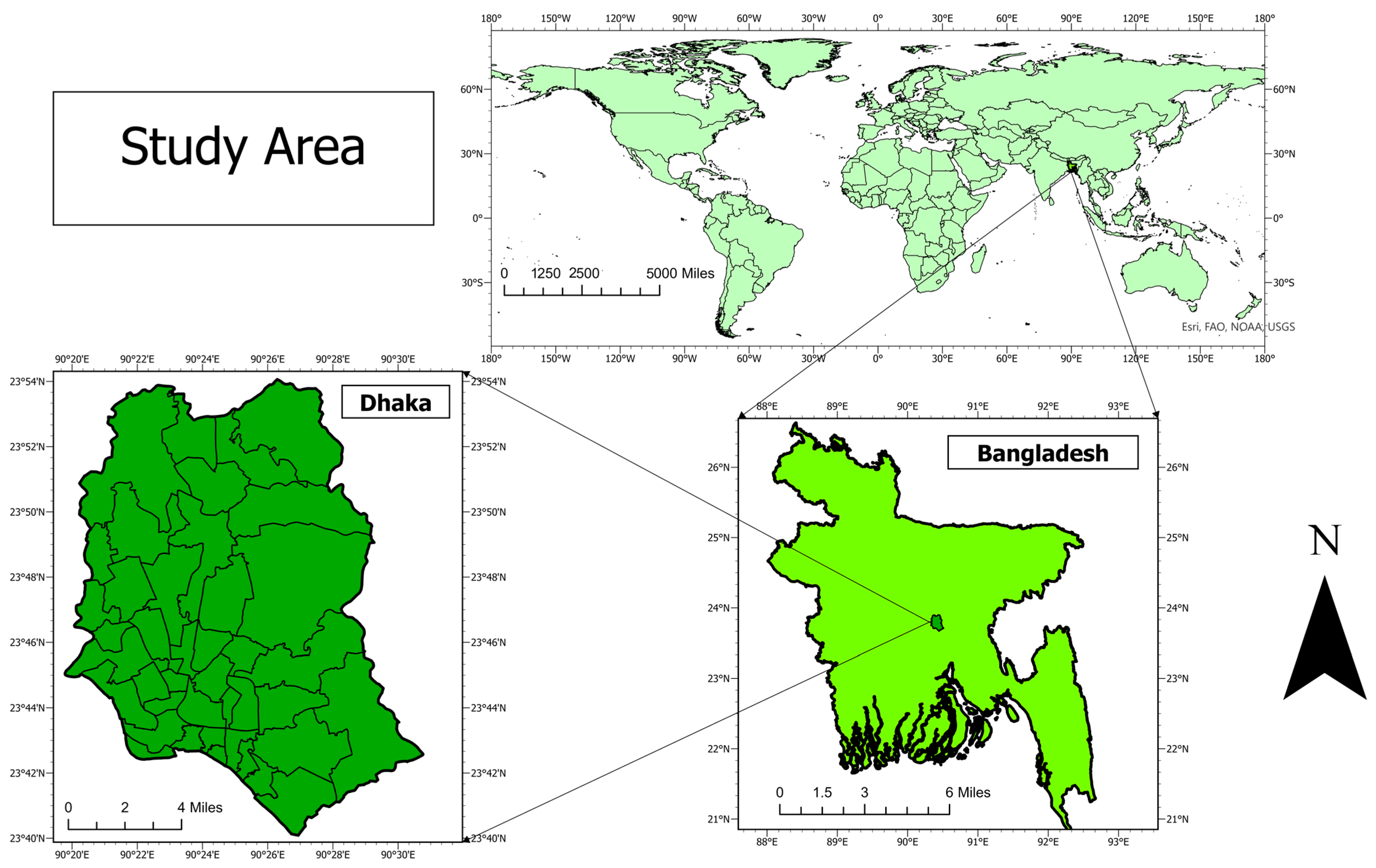
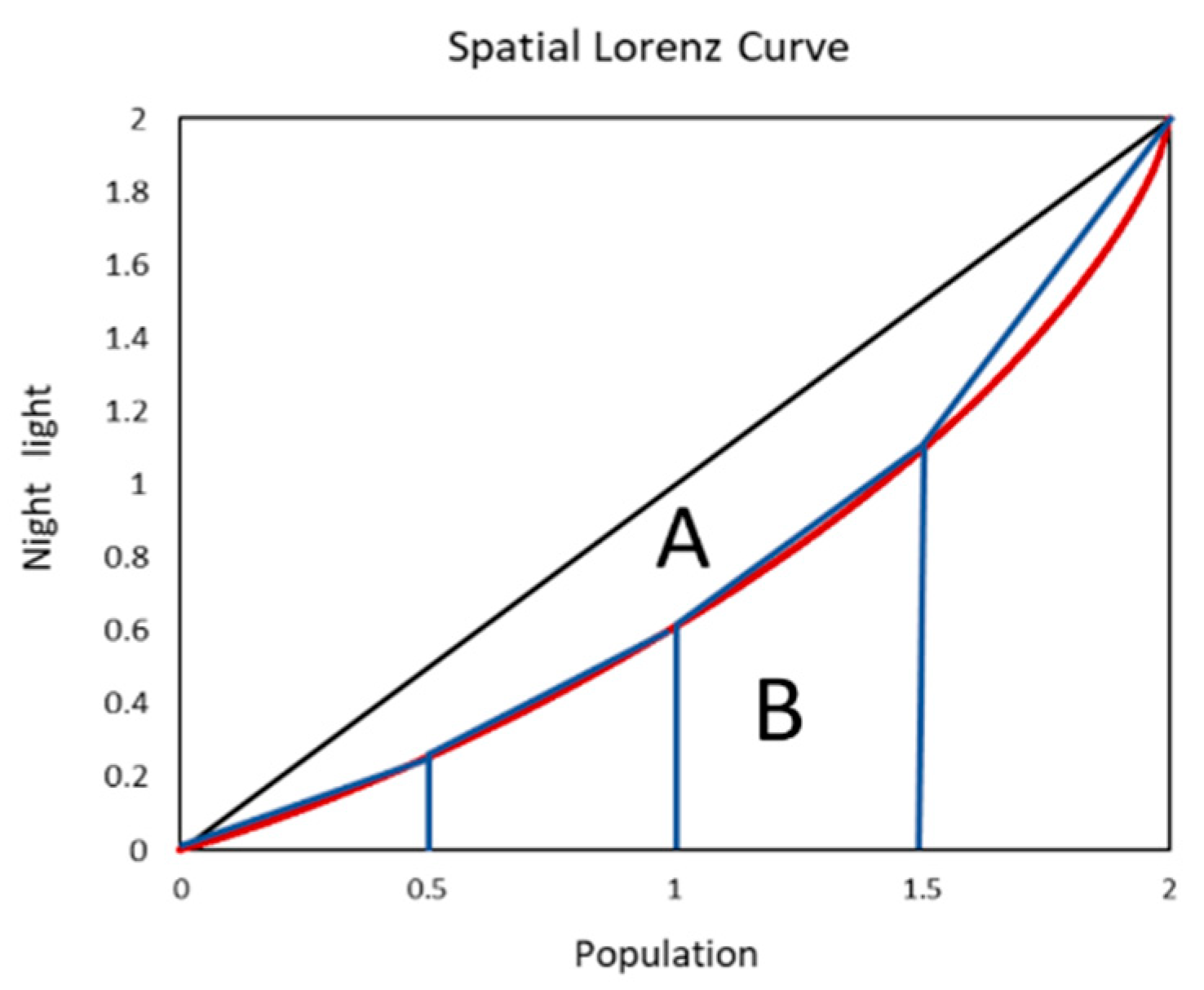

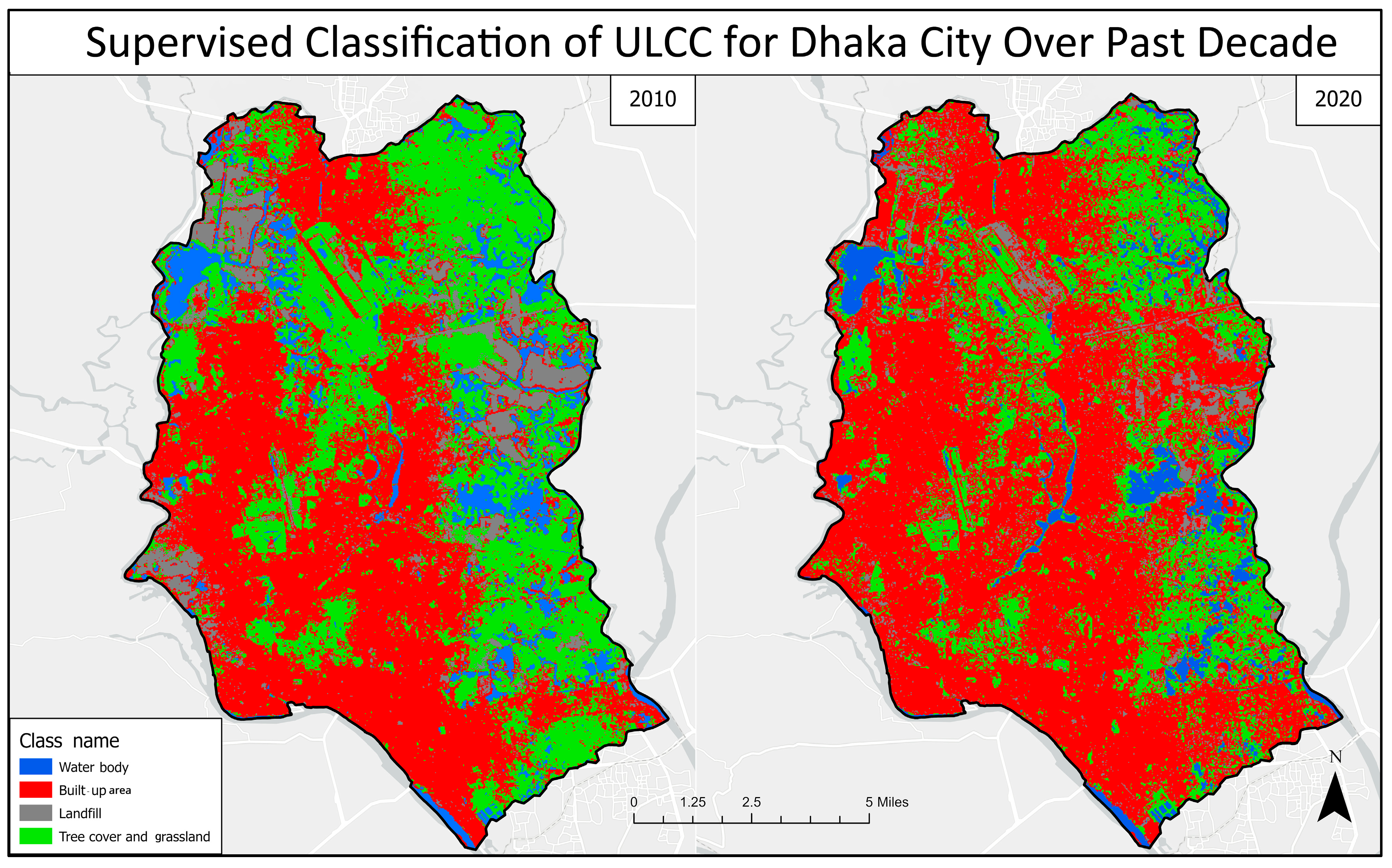

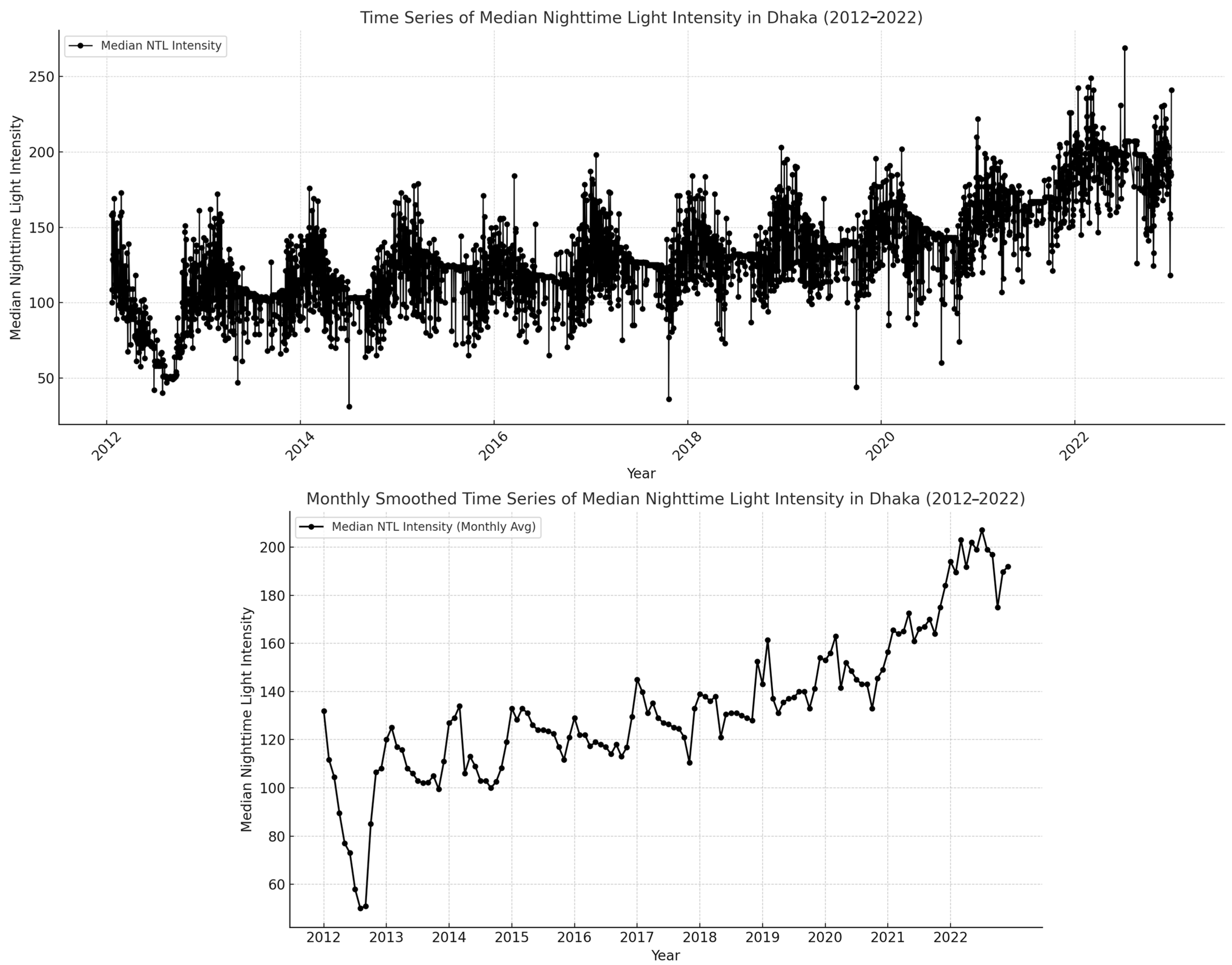
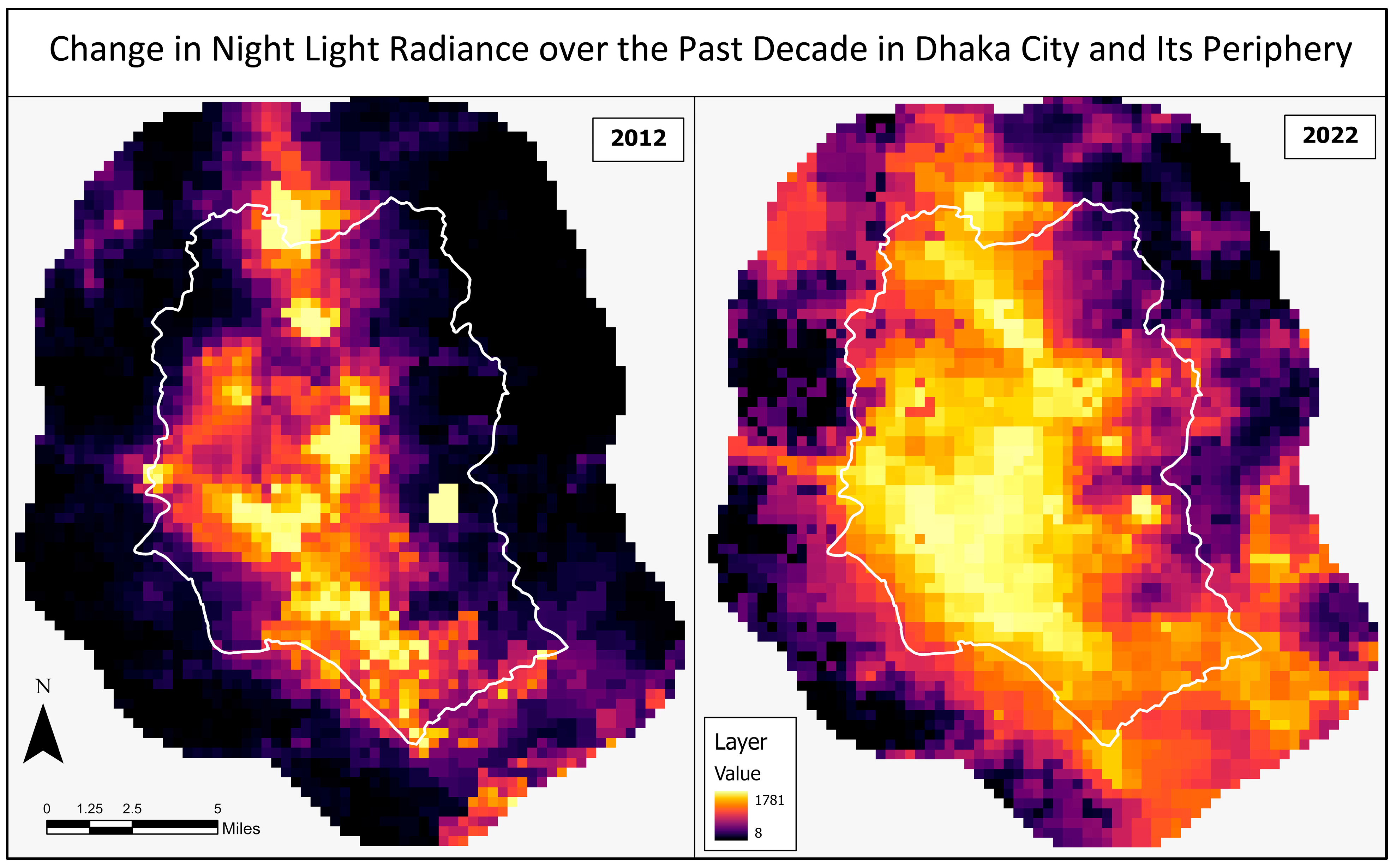
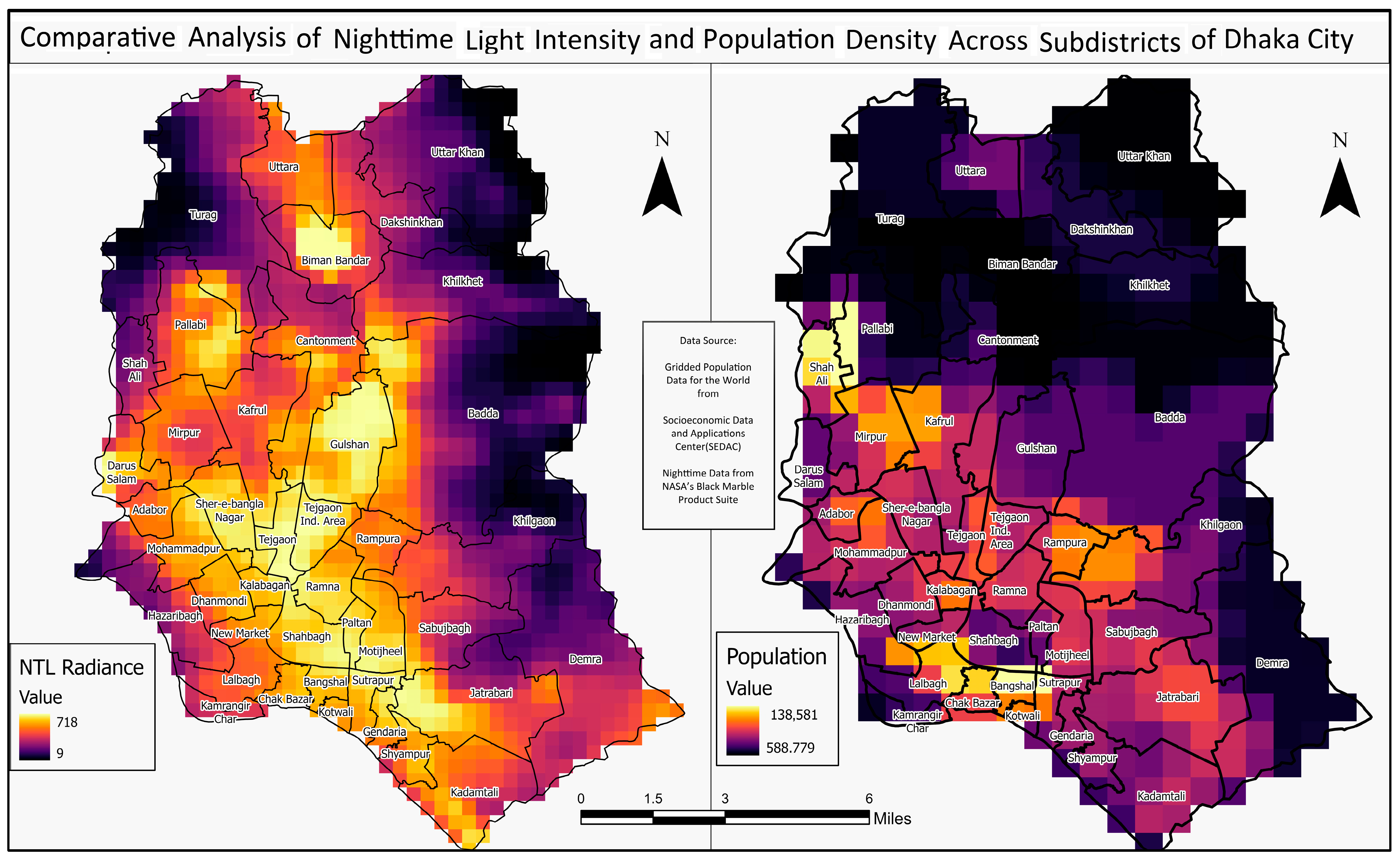
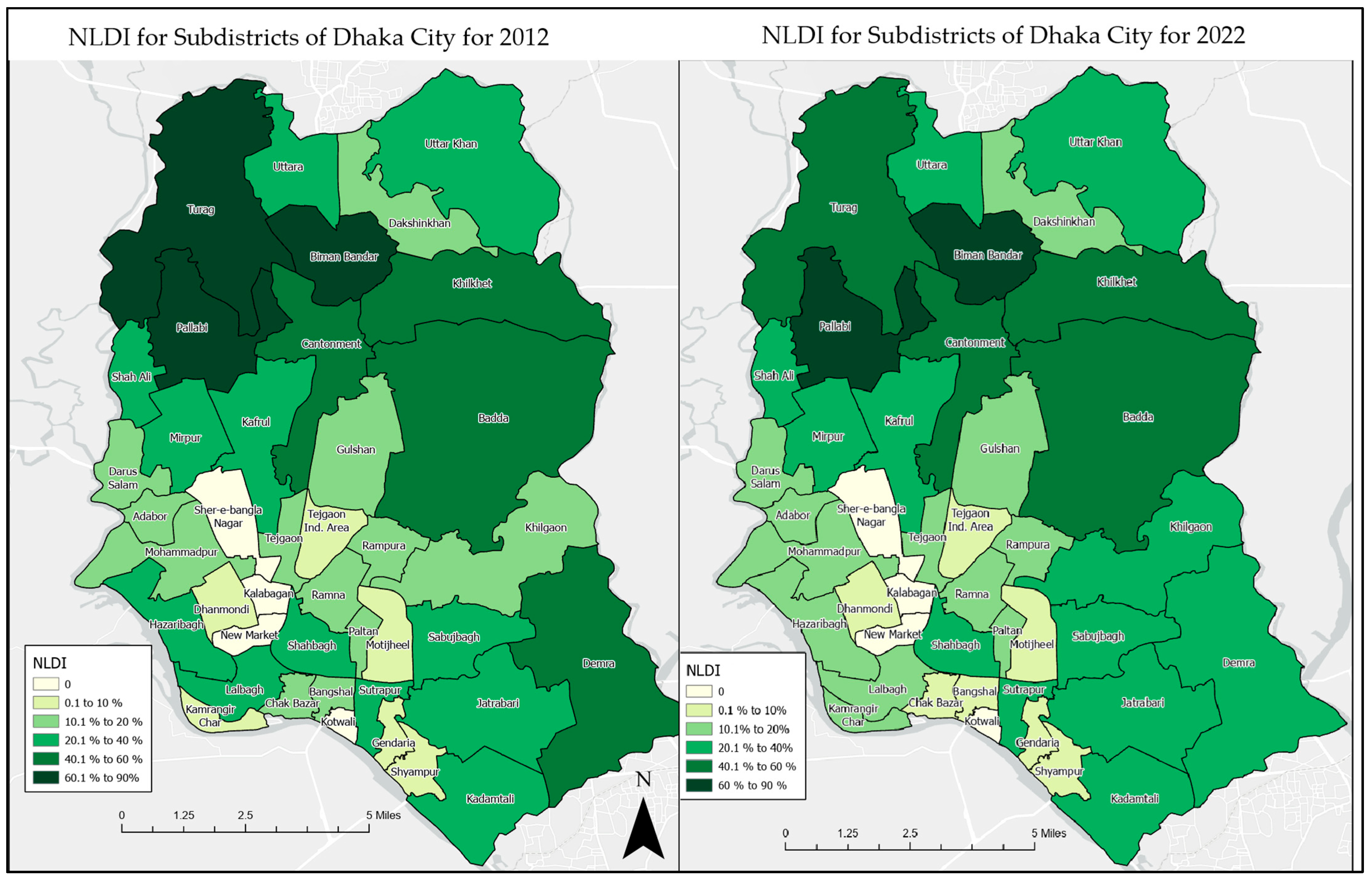
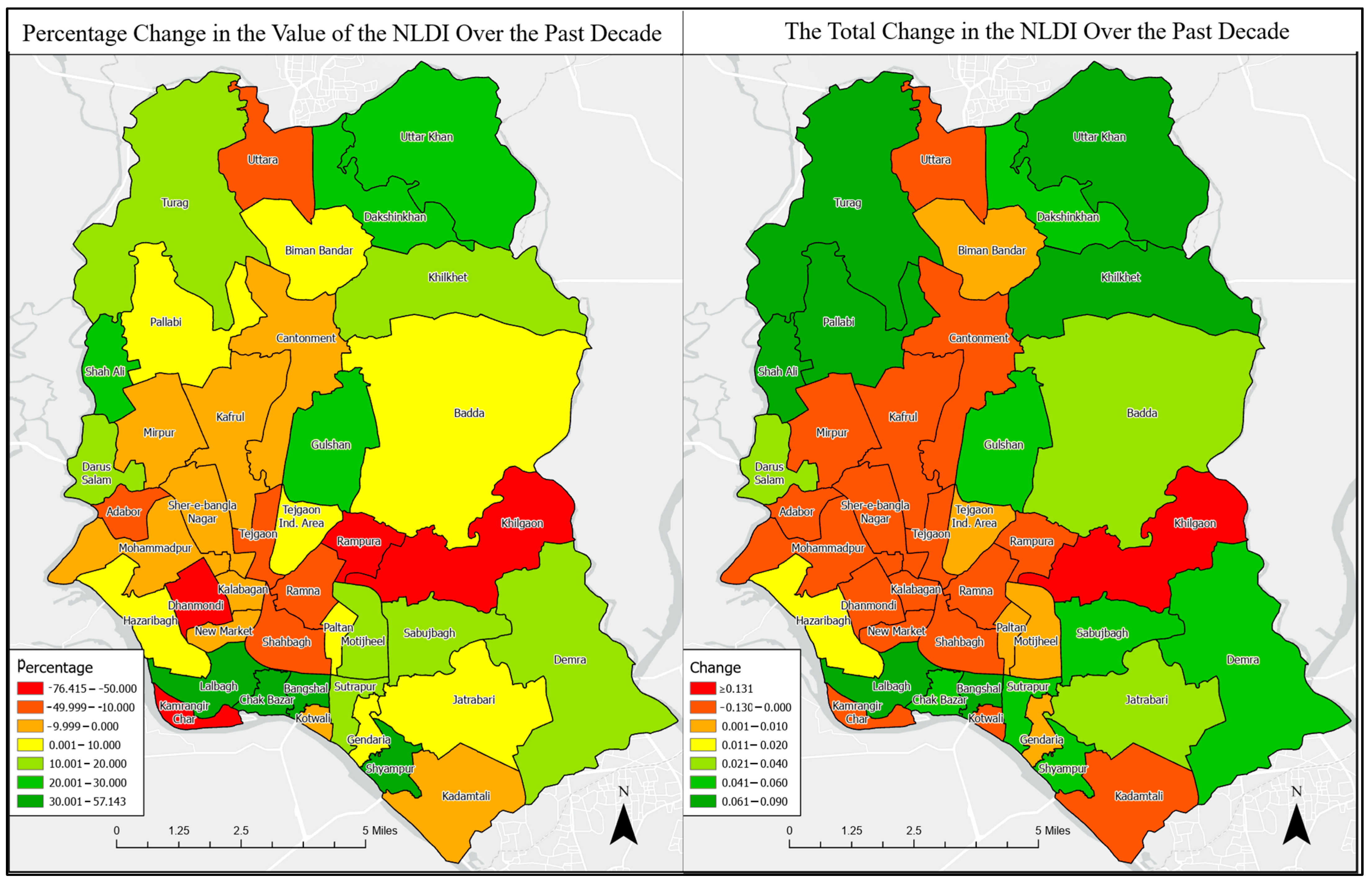
| Satellite | Date of Image Collection | Resolution | Coordinate System |
|---|---|---|---|
| Landsat 5 (TM) | 30 November 2010 | 30 m | WGS 1984 UTM Zone 46N |
| Landsat 8 (OLI) | 25 November 2020 | 30 m | WGS 1984 UTM Zone 46N |
| Land Use/Cover Type | Description |
|---|---|
| Built-up area | Residential, commercial and services, industrial, transportation, roads, mixed urban, other urban areas |
| Landfill | Exposed soils, landfill sites, areas of active excavation, bare land |
| Trees/Grassland | Deciduous forest, mixed forest, palms, scattered trees, scrub, crop fields, grassland, fallow lands |
| Water bodies | River, permanent open water, lakes, ponds, reservoirs |
Disclaimer/Publisher’s Note: The statements, opinions and data contained in all publications are solely those of the individual author(s) and contributor(s) and not of MDPI and/or the editor(s). MDPI and/or the editor(s) disclaim responsibility for any injury to people or property resulting from any ideas, methods, instructions or products referred to in the content. |
© 2025 by the authors. Licensee MDPI, Basel, Switzerland. This article is an open access article distributed under the terms and conditions of the Creative Commons Attribution (CC BY) license (https://creativecommons.org/licenses/by/4.0/).
Share and Cite
Shakibul Islam, K.; Wu, Q.; Islam, M.R.; Abdullah, H.M. Unveiling the Drivers of Unplanned Urbanization: A High-Resolution Night Light Development Index Approach for Assessing Regional Inequality and Urban Growth in Dhaka. Remote Sens. 2025, 17, 1397. https://doi.org/10.3390/rs17081397
Shakibul Islam K, Wu Q, Islam MR, Abdullah HM. Unveiling the Drivers of Unplanned Urbanization: A High-Resolution Night Light Development Index Approach for Assessing Regional Inequality and Urban Growth in Dhaka. Remote Sensing. 2025; 17(8):1397. https://doi.org/10.3390/rs17081397
Chicago/Turabian StyleShakibul Islam, Kh, Qiusheng Wu, Md. Raihanul Islam, and Hasan Muhammad Abdullah. 2025. "Unveiling the Drivers of Unplanned Urbanization: A High-Resolution Night Light Development Index Approach for Assessing Regional Inequality and Urban Growth in Dhaka" Remote Sensing 17, no. 8: 1397. https://doi.org/10.3390/rs17081397
APA StyleShakibul Islam, K., Wu, Q., Islam, M. R., & Abdullah, H. M. (2025). Unveiling the Drivers of Unplanned Urbanization: A High-Resolution Night Light Development Index Approach for Assessing Regional Inequality and Urban Growth in Dhaka. Remote Sensing, 17(8), 1397. https://doi.org/10.3390/rs17081397










